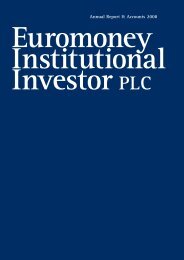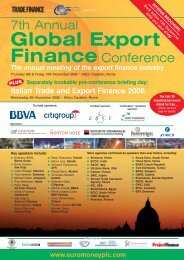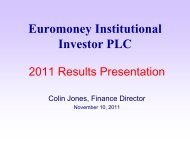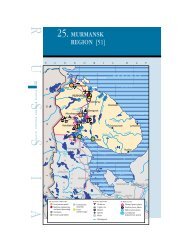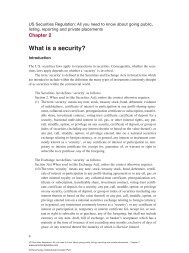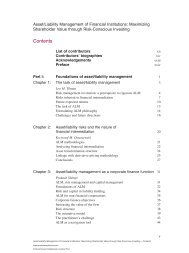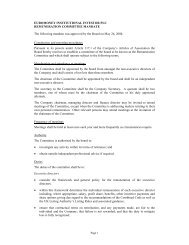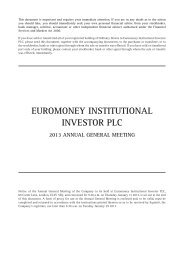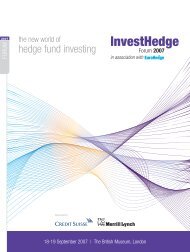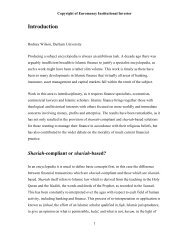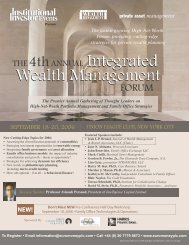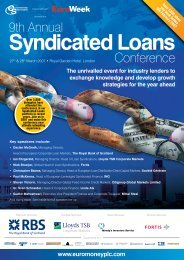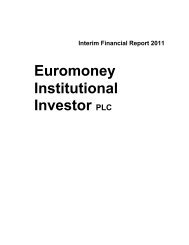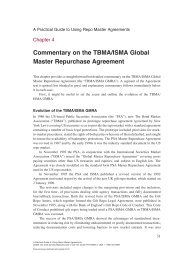Annual Report & Accounts 2012 - Euromoney Institutional Investor ...
Annual Report & Accounts 2012 - Euromoney Institutional Investor ...
Annual Report & Accounts 2012 - Euromoney Institutional Investor ...
You also want an ePaper? Increase the reach of your titles
YUMPU automatically turns print PDFs into web optimized ePapers that Google loves.
<strong>Euromoney</strong> <strong>Institutional</strong> <strong>Investor</strong> PLC <strong>Annual</strong> <strong>Report</strong> and <strong>Accounts</strong> <strong>2012</strong><br />
www.euromoneyplc.com<br />
The group primarily generates revenues from<br />
four revenue streams: advertising; subscriptions;<br />
sponsorship; and delegates.<br />
Advertising revenues represent the fees that<br />
customers pay to place an advert in one or<br />
more of the group’s publications, either in<br />
print or online. Advertising revenue is primarily<br />
generated from the Financial Publishing and<br />
Business Publishing divisions.<br />
Subscription revenues are the fees that customers<br />
pay to receive access to the group’s information,<br />
either through online access to various databases,<br />
through regular delivery of soft copy research,<br />
publications and newsletters or hard copy<br />
magazines. Subscriptions are also received from<br />
customers who belong to <strong>Institutional</strong> <strong>Investor</strong>’s<br />
exclusive specialised membership groups.<br />
Subscription revenue is primarily generated from<br />
the Financial Publishing, Business Publishing and<br />
Research and Data divisions.<br />
Sponsorship revenues represent fees paid by<br />
customers to sponsor an event. A payment of<br />
sponsorship entitles the sponsor to high-profile<br />
speaking opportunities at the conference, unique<br />
branding before, during and after the event<br />
and an unparalleled networking opportunity to<br />
meet the sponsor’s clients and representatives.<br />
Sponsorship revenue is generated from the<br />
Conferences and Seminars division and the<br />
publishing businesses which run smaller events.<br />
Delegate revenues represent fees paid by<br />
customers to attend a conference, training<br />
course or seminar. Delegate revenues are derived<br />
from the Conferences and Seminars and Training<br />
divisions and from smaller events run by the<br />
publishing businesses.<br />
Details of the group’s revenues by revenue<br />
stream and by division are set out in note 3.<br />
The group has a global customer base with<br />
revenue derived from almost 200 countries,<br />
with approximately 60% from the US, Canada,<br />
UK and the rest of Europe and more than a<br />
third of its revenue from emerging markets.<br />
Its customer base predominantly consists of<br />
financial institutions, governments, financial<br />
advisory firms, hedge fund organisations, law<br />
firms, commodity traders, other corporate<br />
organisations and for the group’s niche focused<br />
products relevant niche corporate entities across<br />
the length of the respective supply chain.<br />
The group’s main offices are located in London,<br />
New York, Montreal and Hong Kong.<br />
The group’s costs are tightly managed with a<br />
constant focus on margin control. The group<br />
benefits from having a flexible cost base,<br />
outsourcing the printing of publications, hiring<br />
external venues for events, and choosing to<br />
engage freelancers, contributors, external trainers<br />
and speakers to help deliver its products. Other<br />
than its main offices, the group avoids the fixed<br />
costs of offices in most of the markets in which it<br />
operates. This allows the group to scale up resource<br />
or reduce overhead as the economic environment<br />
in which it operates demand.<br />
The group has strong covenants and takes<br />
advantage of its ability to borrow money cheaply<br />
using these funds to invest in new products<br />
and fund acquisitions. The group’s subscription<br />
revenues are normally received in advance, at<br />
the beginning of the subscription service, and<br />
a typical subscription contract would be for a<br />
12 month period. This helps provide the group<br />
with strong cash flows and normally leads to<br />
cash generated from operations being in excess<br />
of adjusted operating profit – a cash conversion<br />
percentage in excess of 100%.<br />
The board does not micro-manage each business,<br />
instead devolving operating decisions to the local<br />
management of each business, while taking<br />
advantage of a strong central control environment<br />
for monitoring performance and underlying<br />
risk. This encourages an entrepreneurial culture<br />
where businesses have the right kind of support<br />
and managers are motivated and rewarded for<br />
growth and initiative.<br />
The group invests for the long-term in businesses<br />
and products that meet certain financial and<br />
strategic criteria. Equally, where businesses<br />
no longer fit, the group divests. The group is<br />
investing heavily in its program to migrate its<br />
print products online, develop new electronic<br />
information services, and to take advantage of<br />
mobile and cloud technology.<br />
3. Strategy<br />
The key elements of the group’s strategy are:<br />
● driving top-line revenue growth from both<br />
new and existing products;<br />
● building robust subscription and repeat<br />
revenues and reducing the dependence on<br />
advertising;<br />
● improving operating margins through tight<br />
cost control;<br />
● investing in new businesses, technology<br />
and the online migration of its publishing<br />
activities;<br />
● leveraging technology to launch specialised<br />
new electronic information services;<br />
● making acquisitions that supplement the<br />
group’s existing businesses;<br />
● strengthening the company’s market<br />
position in key areas which have the<br />
capacity for organic growth using the<br />
existing knowledge base of the group;<br />
● managing its cash flows to keep its debt<br />
within a net debt to EBITDA limit of three<br />
times; and<br />
● providing incentives to foster an<br />
entrepreneurial culture and retain key people<br />
(see section 4.4.6 of the Directors’ <strong>Report</strong>).<br />
4. Business review<br />
4.1 Group results and dividends<br />
The group profit for the year attributable to<br />
shareholders amounted to £69.7 million (2011:<br />
£45.6 million). The directors recommend a final<br />
dividend of 14.75 pence per ordinary share<br />
(2011: 12.50 pence), payable on Thursday<br />
February 14 2013 to shareholders on the register<br />
on Friday November 23 <strong>2012</strong>. This, together with<br />
the interim dividend of 7.00 pence per ordinary<br />
share (2011: 6.25 pence) which was declared on<br />
May 17 <strong>2012</strong> and paid on July 19 <strong>2012</strong>, brings<br />
the total dividend for the year to 21.75 pence per<br />
ordinary share (2011: 18.75 pence).<br />
Directors’ <strong>Report</strong><br />
Company <strong>Accounts</strong> Group <strong>Accounts</strong><br />
Our Governance<br />
Our Performance<br />
09



